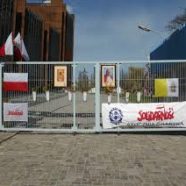
Having recently returned from Gdansk, Poland, following a study mission, my thoughts revolve around the power of places, rituals, and artifacts to evoke spirit. Spirit is a sought after commodity for individuals, teams, organization, and societies. Spirits of innovation, of competitiveness, of service, of cooperation, of performance, and of achievement are among the fires leaders desire to instill within self and their reports. But, beyond a stirring address, leaders often miss the opportunities to connect with the soulful places, rituals, and artifacts that evoke these spirits.
Several colleagues and I met for four days in the European Solidarity Center to conduct an inquiry into vulnerability, transformation, and social movements. This newly completed venue is located on the grounds of the Gdansk shipyard, the scene of the 1980’s Solidarity Movement. The building’s architecture emulates a ship, building character with its steel plate exterior and expansive interior. A world-class museum is housed in the Center, holding thousands of artifacts from decades of struggle. Also, the noted shipyard gate highlighted in the Solidarity Movement has been preserved outside the Center. Truly, this building, along with its museum, research center and grounds, is a soulful place. The spirits of collective struggle and triumph are aroused.
A highlight of the study mission was a session with Lech Walesa, Nobel Peace Prize recipient (1983) and first post-communist Polish Republic President (1990-1995). Listening to his memories and learnings was inspiring…establishing an independent trade union and then leveraging this change into a mass socio-political movement and a democratic Poland. Breaking the chains of communism and Russian control was a remarkable accomplishment. In a soulful manner, he recollected on the principles of the movement and lessons learned. But his spirit was future facing, looking to impact current social systems.
A soulful venue, soulful artifacts, and soulful memories. A soul, although intangible, is the immortal essence of an individual. It is imprinted with many thoughts, experiences, and feelings. Soulful places, artifacts, rituals, or memories bring to the surface deep-seated meaning and feelings within an individual. Differing is the nature of spirit. Spirit is an individual’s life force, in Greek, the breath of life. Spirit creates the future, provides the energy to generate. Through collective spirit, great things can be accomplished. Like individuals, organizations have both spirit and soul characteristics in the collective.
Transformational leadership taps into the vast energies of others, flowing from strong spiritual engagement. If squeamish about considering the words of soul, soulfulness, and spirit within the context of the workplace, think about their absence. Leading zombies to achieve great results is impossible. So, with a spirit of boldness, how might leaders evoke spirit?
Soulful Places
The soul speaks to the feeling of walking through your childhood home. Spirit speaks to the stimulating vision of building a new home. A few examples that express the power of place:
- A Palo Alto, Calif., home garage is where William Hewlett and David Packard launched the world renowned HP Corp. in 1938. Considered the birthplace of Silicon Valley, the place is now a private museum and listed on the National Register of Historic Places. HP leaders point to this simple structure to evokes the spirits of beginnings and entrepreneurship.
- The Folgers Coffee plant in downtown Kansas City, Mo., where I first served as a plant manager for Procter & Gamble, was recently converted to condominiums. After decades of spirit investment by thousands of people, the conversion and partial demolition of this manufacturing plant were sad occurrences. This is because the buildings housed the imprints of our creativity and efforts. But to the new tenants, these buildings now induce spirits of excitement and new beginnings that celebrate Midwest history.
- I also visited the Emigration Museum in Gdynia, Poland, during my study mission. It is a restored 1933 passenger port building housing a museum that tells the stories of 20 million people from Polish lands seeking a new life or exiled from their homes over a century of time. It is a soulful place, filled with the spiritual imprints of millions on a journey to other places in the world. Much in the same way as Ellis Island speaks to Americans; this place speaks to the spirits of resiliency and hope.
- Nature is a powerful place often underutilized by organizations. During leadership conferences, we seek to place people in nature to ‘ground’ self and clear the mind. In the modern workplace, our nature origin can be excluded, leading to a spirit of temporariness versus timelessness.
Bring meaning to the place of work. Create spaces that evoke the sought after spirits. Connect people to history and the world to emphasize the spirit of grounding for future growth and development.
Soulful Rituals and Artifacts
Organizational rituals are numerous, but often without much thought for the future. Beginning with morning greetings to meeting standards and company events, rituals have a way of forming without consciousness. What rituals make your organization unique? What rituals stand out in the workplaces that are not necessarily found in away-from-work behaviors? Beware of Leviticus-laden rituals that fail to hold meaning today.
Artifacts, from the framed first dollar earned to first products manufactured, can be just about anything of meaning. Examples include a historical car in the lobby of automobile headquarters, a model ship in the offices of a steamer company, Nike headquarters and buildings named after sport heroes with artifacts of their competitive careers displayed on the first floor.
These rituals and artifacts can prompt a soulful recollection, possibly leading to a spirit spark. At the same time, the meaning may have been lost and forgotten. Take an inventory. Ask why they now exist and the purposes served? Refresh, eliminate or create anew? Do these rituals and artifacts give meaning and focus attention forward?
Soulful Memories
Leaders can bring forth collective memories that serve to promote purpose, vision, and values. The art of storytelling can cast valuable meaning on the past. Be clear about the forward spirit the story intends to induce.
And for you the leader, what memories do you have and what meanings do you project upon them? A soulful memory of failure can be used to conjure fear of risk or the resiliency to take bold actions. Don’t see the spirit emanating from these memories as happenstance, shape them to speak to a specific spirit.
Soulful to Spirit Considerations
- What places hold special meaning for your organization? What are their histories and how might these spaces be leveraged and honored? These places may be part of the organization’s history or of some other historical significance. It may be an existing place or a representation of a past, or materials of the past may be used in creating new space (as World Trade Center materials were). What desired spirit are you speaking to?
- What rituals are practiced by your organization? How did these rituals evolve? What are their meanings? Are there rituals that have lost their meaning and now evoke a deadening of the spirit (discard quickly)? What artifacts cherished by the organization? Are both used to reflect and to evoke spirit to move forward? What is the nature of the spirit being cultivated? Who shepherds these rituals and chooses the artifacts?
- What past experiences in your life bring forth soulfulness? Concerning the emotions flowing from these experiences, how do you process them, how do you use them to strengthen your spirit?
Leadership opportunities present constantly when considering the role of soulful places, rituals, and artifacts; it is a chance to evoke desired collective spirit toward future achievements. You just have to see through spirit lenses, which is hard to do in a concrete world.



